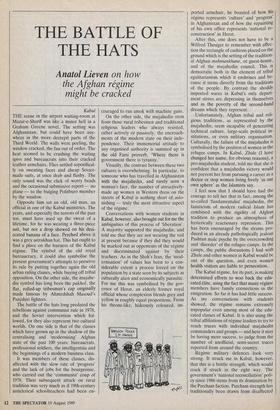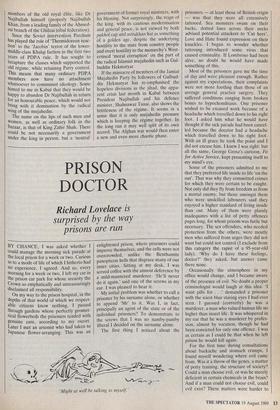THE BATTLE OF THE HATS
Anatol Lieven on how
the Afghan regime might be cracked
Kabul THE scene in the airport waiting-room at Mazar-e-Sharif was like a minor hell in a Graham Greene novel. The setting was Afghanistan, but could have been any- where in the more decrepit parts of the Third World. The walls were peeling, the window cracked, the fan out of order. The heat seemed to be crushing the waiting spivs and bureaucrats into their cracked leather armchairs. Flies settled soporifical- ly on sweating faces and cheap Soviet- made suits, at once drab and flashy. The only sound was the click of worry beads and the occasional submissive report — no plane — to the bulging Politburo member by the window.
Opposite him sat an old, old man, an official in one of the Kabul ministries. The years, and especially the terrors of the past ten, must have used up the sweat of, a lifetime, for he was wearing a three-piece suit, but not a drop showed on his desi- ccated banana of a face. Perched above it was a grey astrakhan hat. This hat ought to find a place on the banners of the Kabul regime. The symbol of the old royal bureaucracy, it could also symbolise the present government's attempts to preserve its rule by putting together again the old urban ruling classes, while buying off tribal opposition. On the other side, the mujahe- din symbol has long been the pakhol, the flat, rolled-up tribesman's cap originally made famous by Ahmedshah Masoud's Panjshiri fighters.
The battle of the hats long predated the rebellions against communist rule in 1978, and the Soviet intervention which fol- lowed, for they also represent two cultural worlds. On one side is that of the classes which have grown up in the shadow of the centralising and 'modernising' Afghan state of the past 100 years: bureaucrats, professional soldiers, the intelligentsia and the beginnings of a modern business class.
It was members of these classes, dis- affected with the slow rate of 'progress' and the lack of jobs for the bourgeoisie, who carried out the 'communist' coup of 1978. Their subsequent attack on rural tradition was very much as if 19th-century anticlerical schoolteachers had been en- couraged to run amok with machine guns.
On the other side, the mujahedin stem from those rural tribesmen and traditional religious leaders who always resisted, either actively or passively, the encroach- ments of the modern state on their inde- pendence. Their immemorial attitude to any organised authority is summed up in the old Farsi proverb, 'Where there is government there is tyranny.'
Visually, the contrast between these two cultures is overwhelming. In particular, to someone who has travelled in Afghanistan with the mujahedin, and rarely seen a woman's face, the number of attractively- made up women in Western dress on the streets of Kabul is nothing short of, asto- nishing — truly the most attractive aspect of the regime.
Conversations with women students in Kabul, however, also brought out for me the ambiguities of this process of 'liberation'. A majority supported the mujahedin, and told me that they are not wearing the veil at present because if they did they would be marked out as opponents of the regime and discriminated against by their teachers. As in the Shah's Iran, the 'mod- ernisation' of values has been to a con- siderable extent a process forced on the population by a state seen by its subjects as culturally alien and economically parasitic. For me this was symbolised by the gov- ernor of Herat, an elderly former royal official whose complexion blends grey and yellow in roughly equal proportions. From his throne-like, hideously coloured, im-
ported armchair, he boasted of how his regime represents 'culture' and 'progress in Afghanistan and of how the repainting of his own office represents 'national re- construction' in Herat.
After this, one does not have to be a Wilfred Thesiger to remember with affec- tion the rectangle of cushions placed on the ground which is the setting of the tradition- al Afghan mehmankhane, or guest-house, and of the mujahedin council. This is democratic both in the element of tribal egalitarianism which it enshrines and be- cause it stems directly from the traditions of the people. By contrast the shoddy imported wares in Kabul's only depart- ment stores are depressing in themselves and in the poverty of the second-hand dreams which they represent.
Unfortunately, Afghan tribal and reli- gious traditions, as represented by the mujahedin, seem incapable of generating technical culture, large-scale political in- stitutions, or even military organisation. Culturally, the failure of the mujahedin is symbolised by the position of women in the refugee camps. In Kabul, Zhale (I have changed her name, for obvious reasons), a pro-mujahedin student, told me that she is confident that a mujahedin victory would not prevent her from pursuing a career as a doctor or stop women living freely in our own sphere' as the Islamists say.
I feel now that I should have had the courage to tell her that in fact, among the so-called 'fundamentalist' mujahedin, the fanaticism of modern radical Islam has combined with the rigidity of Afghan tradition to produce an atmosphere of hysterically reactionary repression. This has been encouraged by the strains pro- duced in an already pathologically jealous Pashtun male psyche by the overcrowding and 'disorder' of the refugee camps. In the camps, the public discussions I had with Zhale and other women in Kabul would be out of the question, and even women health visitors are liable to persecution.
The Kabul regime, for its part, is making determined efforts to woo back the edu- cated elite, using the fact that many regime members have family connections in the emigration. So far it has had little success. As my conversations with students showed, the regime remains extremely unpopular even among most of the edu- cated classes of Kabul. It is also using the tribal affiliations of regime leaders to try to reach truces with individual mujahedin commanders and groups— and here it may be having more success, to judge from the number of unofficial, semi-secret truces reported from around the country.
Regime military defences look very strong. It struck me in Kabul, however, that this is a brittle strength, which would crack if struck in the right way. The government's 'national reconciliation' poli- cy since 1986 stems from its domination by the Parcham faction. Parcham strength has traditionally been drawn from disaffected members of the old royal elite, like Dr Najibullah himself (properly Najibullah Khan, from a leading family of the Ahmed- zai branch of the Ghilzai tribal federation).
Since the Soviet intervention Parcham has played the role of `Thermidorean reac- tion' to the 'Jacobin' terror of the lower- middle-class Khalqi faction in the first two years of PDPA rule. It has sought to recapture the classes which supported the old regime, while retaining Party control. This means that many ordinary PDPA members now have no attachment whatsoever to communist ideology. Some hinted to me in Kabul that they would be happy to abandon Dr Najibullah in return for an honourable peace, which would not bring with it domination by the radical wing of the mujahedin. The name on the lips of such men and women, as well as ordinary folk in the bazaar, is that of King Zahir Shah. There could be not necessarily a government under the king in person, but a 'neutral' government of former royal ministers, with his blessing. Not surprisingly, the reign of the king, with its cautious modernisation and general peace, is not viewed by both pakhol cap and astrakhan hat as something of a golden age, despite the underlying hostility to the state from country people and overt hostility to the monarchy's West- ernised 'moral corruption' on the part of the radical Islamist mujahedin such as Gul- buddin Hekmatyar.
If the massacre of members of the Jamiat Mujahedin Party by followers of Gulbud- din Hekmatyar has re-emphasised the hopeless divisions in the jihad, the appa- rent crisis last month in Kabul between President Najibullah and his defence minister, Shahnawaz Tanai, also shows the brittleness of the regime. It seems in a sense that it is only mujahedin pressure which is keeping the regime together. In the long run it may well split of its own accord. The Afghan war would then enter a new and even more chaotic phase.



















































 Previous page
Previous page